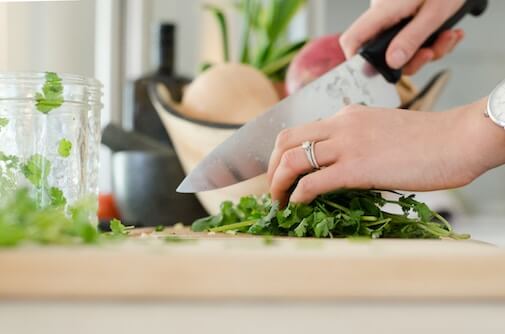Regardless of why your cooking activity may have increased recently, it’s important to keep in mind that there can be many dangers lurking in the kitchen, with some being more unexpected than others.
Some of the troublemakers can cause a few days of digestive upset but others can be deadly, especially to young children and to those with compromised immune systems.
Read on to find out what could be making you sick in your kitchen, and learn some hints and tips on how to manage food and safety hygiene in a natural way.
Food Handling
As much as cooking from scratch is a wonderful thing, a few simple rules must be followed to ensure that your food handling is done safely. If food is not cooked and handled safely, bacteria can multiply rapidly. You definitely don’t want to compromise the health of little ones or those with weakened immune systems by giving anyone food poisoning; let alone making yourself sick!
When handling food beware of…
- Under Cooking Foods –
- Cook foods through to their respective appropriate temperatures to kill bacteria.
- Left Overs at the Wrong Temperature –
- Keep hot foods above 60C and cold foods below 4C to prevent bacteria, yeast and mould forming. Never leave foods to marinate or defrost for long periods outside the fridge.
- Unwashed Produce-
- Washing helps remove bacteria and pesticides.
- Rinsing Off Raw Meat
- Doing so in the sink simply spreads bacteria. Cooking thoroughly will kill any potentially harmful germs.
- Cross-Contamination Between Raw & Cooked Foods-
- Always use separate cutting boards for raw meats and fresh vegetables. Store raw meats and fish well-sealed and separate from other fresh or cooked produce. Never return cooked meat or fish back onto the dish it was on prior to cooking/when marinating.
- Skipping Hand Washing-
- Wash your hands as you move through your food prep, especially between meat, eggs and fresh produce.
Trusty tea towels are a staple in every kitchen, but if not washed often enough they can harbour some pretty nasty germs, including Salmonella or E.coli. To reduce the risk use separate tea towels for drying hands, food preparation and cleaning. Allow them to dry out fully after each use and hot wash regularly.
Cutting Boards
With every use, cutting boards receive little cuts and scratches: places in which bacteria loves to bury itself. This, combined with cross-contamination from not using separate boards for meat, fish and vegetables, means that chopping boards potentially pose a severe health risk.
Plastic or Glass Cutting Boards
Ideally run through the dishwasher if space allows. Alternatively, hand wash in hot, soapy water. If your plastic cutting board has seen lots of wear and tear, throw it away and get a new one. Cuts into plastic run deep and therefore will harbour even more bacteria which becomes difficult to remove.
Wooden Cutting Boards:
Avoid placing in a dishwasher as this can cause warping of the wood. Instead, wash after every use in hot, soapy water, then dry thoroughly. Ideally, after washing rub over your wooden board with half a fresh lemon before leaving it out in the sunshine to fully dry and kill bacteria. Regularly oiling your wooden board will also help prevent it from cracking and splitting.
Cloths & Sponges
The porous nature of sponges may make them great for cleaning up, but it also makes them particularly susceptible to retaining moisture and bacteria. After use, wash sponges and cloths in hot, soapy water and leave them to thoroughly dry out. You can also run them through the dishwasher or in with your laundry.
If you get even the faintest whiff of a nasty smell on your sponge or cloth after a clean then discard it immediately as this is a sign of substantial bacterial growth
Handles, Knobs and Touch Pads
As much as we’d like to hope our hands are perfectly clean all the time, this simply isn’t the case. If you then think about how many times in a cooking session, let alone a day, you touch all the various knobs, handles and touchpads within your kitchen it is scary to imagine quite how much potentially harmful bacteria gets left behind on these surfaces.
The solution? At least once a day, if not after every cooking session, clean these surfaces using an antibacterial wipe or disinfectant spray.

